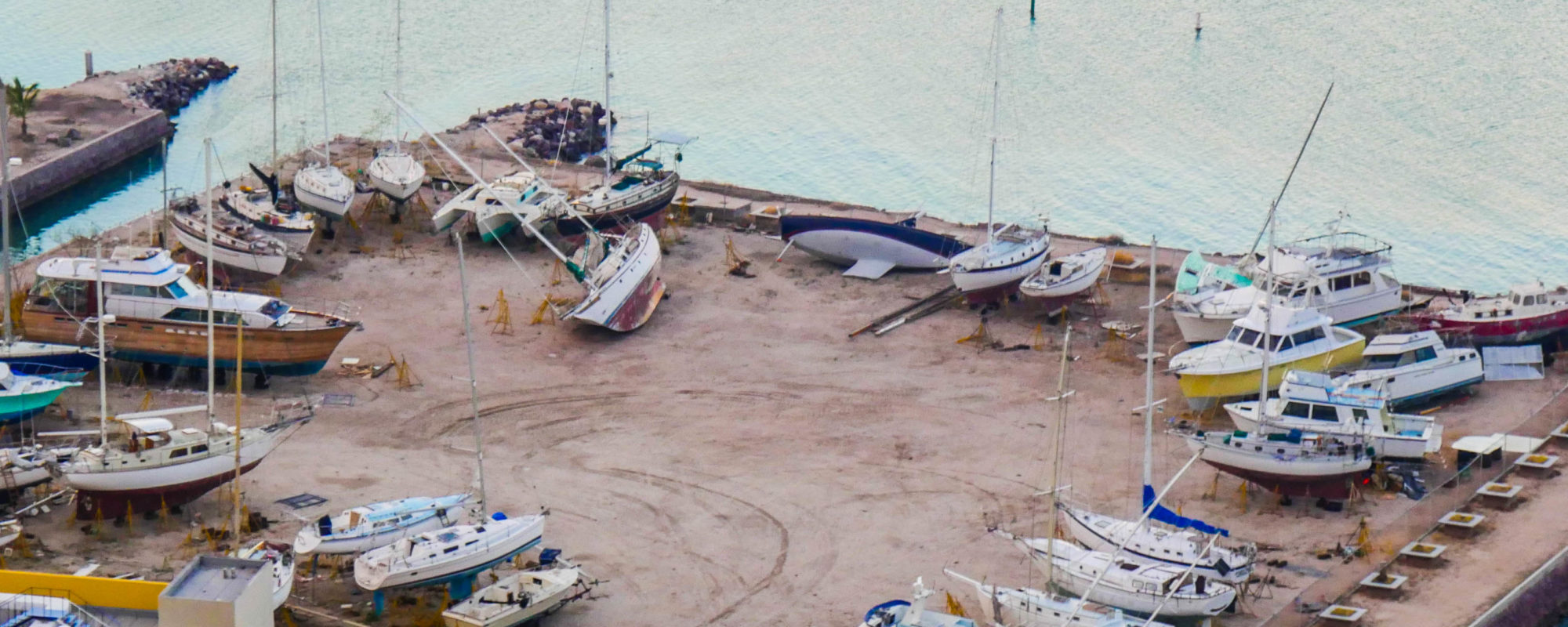Last week, 195 nations meet in Paris to decide the fate of the systems that support life on earth. Again.
Since 1995, a majority of the world’s countries has met every year but failed to reach a lasting agreement to figure out what to do about the warming planet. This annual event, which weighs heavier every year as the globe skids toward irreversible warming, is called the United Nations Framework on Climate Change (UNFCC) Conference of Parties (COP). This year, they met in Paris—and came to a remarkable international agreement.
Everyone came together in the first place because most nations continue to burn coal, oil, and gas, which clogs the atmosphere and causes the earth to warm. Here’s how this works: the sun’s rays penetrate the atmosphere then bounce off the earth and reflect back into space. Normally the atmosphere traps some of the light and heat, making life on earth possible in the first place. But extra particles from burned carbon are trapped in the atmosphere and trap more heat. It’s a little like going from a screened porch to a glass porch—it’s way warmer inside the glass porch (hence the term ‘greenhouse effect.’) Heat is energy, and more energy trapped in our atmosphere changes weather patterns and gives rise to extreme events such as floods, droughts, and hurricanes. Collectively this phenomenon is ‘climate change.’ Extreme weather influenced by this change has killed more than 600,000 people and harmed more than 1.4 billion individuals since climate talks began 20 years ago,1 double the frequency of weather related events from the prior ten years.
The world’s poorest are both the least responsible and the most affected.2 Getting countries to agree to cut emissions, even with a handshake instead of ink, requires nations to struggle quantitatively with these disparities: how much should the rich nations (built on empires of burned coal) pay to compensate people and places who have lost their water, growing season, or shelter? And will these same nations pay to get solar, wind, and geothermal energy to replace cheap coal or diesel in developing countries? Getting at these numbers has stalled the talks before.
And for good reason. Developed nations built their advanced economies on coal and oil, (often imported from less developed countries,), and rapidly developing states want to elevate their people on a similar path. Prakash Javadekar, India’s environmental minister, put it this way in September: “Today, I see the carbon space occupied by the developed world. We are asking the developed world to vacate the carbon space to accommodate us. That carbon space demand is climate justice.” Not exactly fighting words—but a sharp expression of the divide between haves and have-nots when it comes to climate change.3
Fortunately, the factors that caused climate negotiations to crash in the past—stern talk of enforcement, lack of commitment from international powers, and ignoring small nations—were carefully and specifically avoided this time, much of it even before the talks began. Everyone got a voice, from Kiribati to China. 195 nations agreed to start cutting emissions by the middle of the century, and all agreed to work towards keeping the temperature below 1.5 degrees Celsius, or 2.5 degrees Fahrenheit. (The lower the temperature, the less chance of melting the massive Greenland and Antarctic ice sheets, which have an unknown tipping point.) The deal leaves out just how much developed countries will compensate growing nations for new technology and adaptation. Yet it finally recognizes liability for current and future damages—without using that specific “L” word. The agreement may lack teeth, but at least it’s a full formed creature capable of growing them.
And grow teeth it must, since climate change is already changing people’s lives in places like the Mexican coast. When I started sailing the Baja peninsula, I did not think I would find people’s lives already altered—but to my surprise, the changes started brewing in the ocean decades ago. Our coastal Mexico exploration has already yielded glaring evidence of the insidious, long term effects of extreme weather—and the resourceful ways that officials and ordinary citizens are attempting to cope.
It’s through extreme weather, fueled by warmer oceans, that we saw these changes. On the heels of a nervously successful climate deal, this is the story of two recent hurricanes in Mexico, Odile and Patricia, which illustrate the long reach of climate change—and what’s in store if it tightens its grip.
One Year Ago: Hurricane Odile
On September 17th, 2014, Mike and Nia were secured to a mooring on their 28-foot sailboat, Azul, in the natural inner harbor of Puerto Escondido. Along with about 50 other boats, they awaited the arrival of Hurricane Odile—which turned out to be the strongest recorded hurricane ever to hit the Baja peninsula.4
Once the wind reached above 30 knots, it turned the rain into fat needles. They could no longer walk to the front of their boat to check on the ropes that kept them attached to their mooring ball—they could only crawl. As wind speed increases, the force of the wind rises exponentially; in other words, 40 knots does not feel like just ten knots more than 30, it packs a much more powerful punch. Once over 60 knots, Mike and Nia hunkered down in the cabin of the boat as it surfed back and forth in the wind, tugging at the mooring. Although they couldn’t see it, boats nearby had either sunk or washed up on the rocks. One boat dragged from one part of the anchorage toward the land, taking out five more boats in its path before it plowed into the shore.
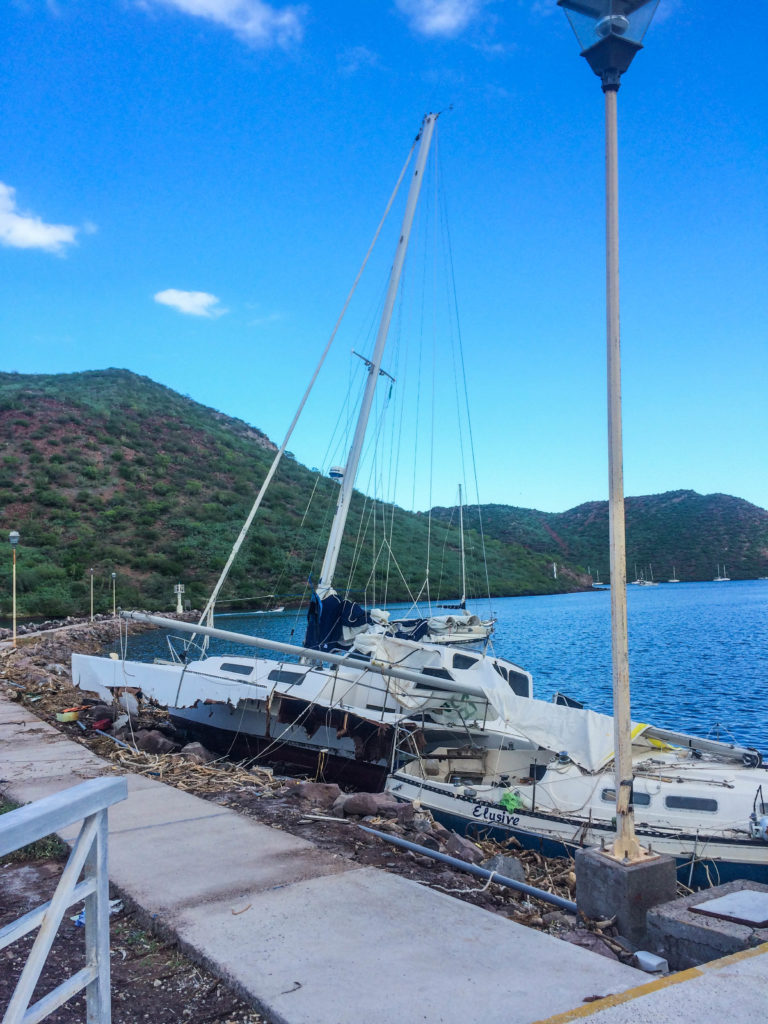
Odile first made landfall 200 miles south, in Los Cabos, the twin tourist cities on the tip of the peninsula. This area parties like Cancun and is home to over 170,000 people, over a quarter of whom live in poverty and subpar housing. The hurricane swept ashore at night, intensifying the chaos. Odile tore apart the international airport, leaving 30,000 tourists stranded as looters ravaged the city. Hotels and housing that were not built with concrete blocks were torn apart by sustained 100-mile-per-hour winds.
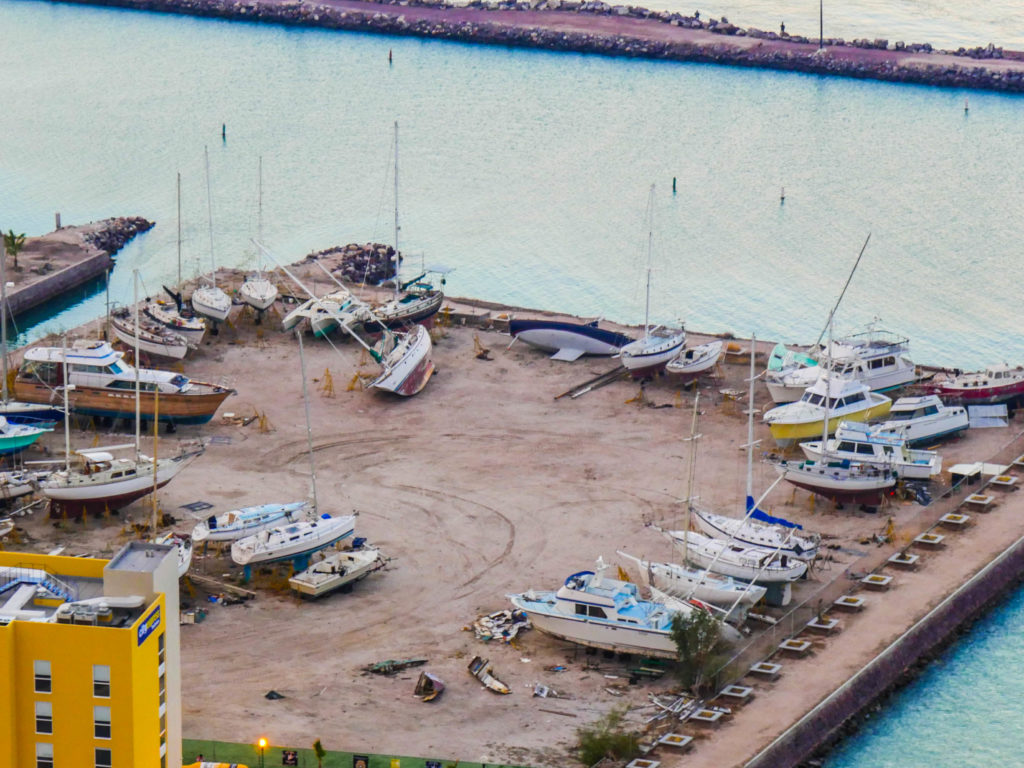
From Cabo, the hurricane traveled northward for the entire peninsula, first hitting La Paz then pounding Loreto, Mulegé, Santa Rosalía, and Bahía de Los Angeles. The storm caused 11 direct deaths and approximately one billion dollars in damages.
Aboard our 39-foot sailboat Oleada, my partner Josh and I followed the path of Odile one year later. We did not know what scars we would see on the landscape and on the people—but we heard about the stubborn, lingering effects that continue to shape these communities, beginning with the surprisingly long scar inflicted on tourism.
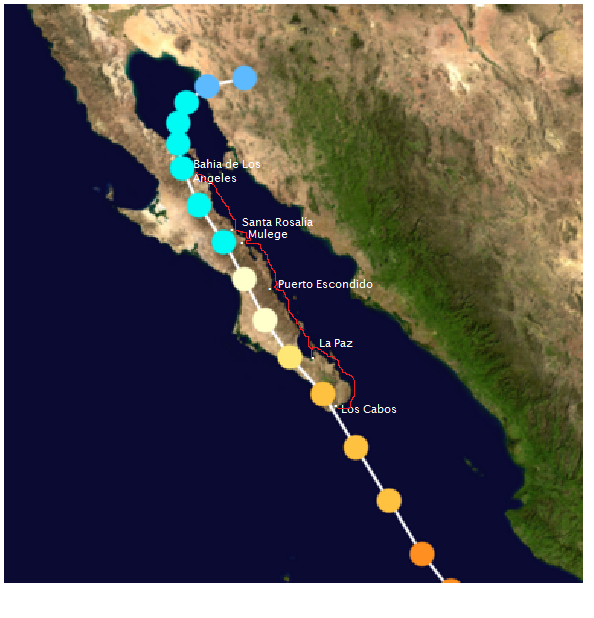
Tourism
More US tourists visit Mexico than any other country, and the majority of tourists head for the beaches. Tourism comprises over 70 percent of the economy of the state of Baja California Sur. While Cabo San Lucas and its sister city, San Jose del Cabo, attract visitors ranging from underage spring breakers to celebrities like George Clooney, other towns on the Baja coast attract serious fishermen, sailors, whale-watchers, and people seeking the tranquility of the desert and the sea.
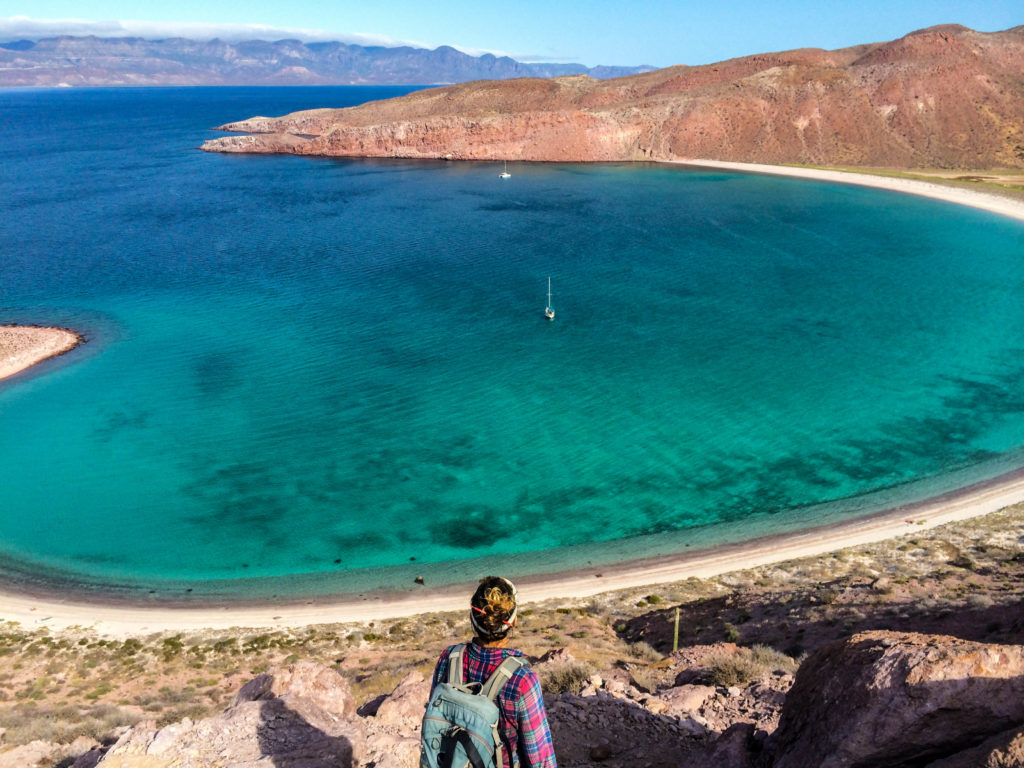
This eastern coast of Baja is one of the most popular sailing destinations in the world. During the summer months, predictably calm seas and south winds make for sailing conditions that are both excellent and rare. But from August to November, we didn’t see another sailboat underway. Not one.
Although we traveled in the heart of hurricane season, the Baja coast provides unusually safe places to weather a storm. We were always within a day or two sailing distance from a ‘hurricane hole,’ a natural harbor that provides protection from big storms. This coast lends itself to safe travel in this way—and as we traveled north, we moved to statistically safer areas, since few hurricanes make it all the way to Bahía de Los Ángeles.
We were told that we would enjoy local hospitality and meet many long-time sailboat ‘cruisers’ as we made our way up the coast. We met many charismatic and open-hearted local fishing families—but there was no trace of another sailboat. As we arrived in Puerto Escondido, a popular hurricane hole, we were shocked to see only a dozen sailboats in an anchorage that can accommodate a hundred.
When I spoke with Raquel Murillo Villalejo, the administrator at the marina office that oversees Puerto Escondido, she told me that the summer was strangely quiet. She gestured to the boatyard where people leave their boats ‘on the hard,’ out of the water while they are away: the sailboats were packed tightly together on their stands on the pavement. The boatyard was full of boats—and the water was empty. Is this normal? I asked.
She chuckled. “Absolutely not, it’s never this quiet,” she said. “But people were afraid to sail their boats in the summer after the hurricane last year.”
Mexico really wants sailing tourism, so increasing storms present a conundrum. In 2005, the National Fund for Tourism (FONATUR), instituted the Escala Nautica project, building 15 quality marinas in popular cruising locations throughout the Sea of Cortez and Pacific Mexico. The marina at Puerto Escondido is a FONATUR project, and as we traveled north, Josh and I looked forward to visiting the other Baja FONATUR marina in Santa Rosalía, wondering if we would find more sailors there that might justify these marina projects.
But when we arrived, the docks were almost empty. In addition, the other marina we read about in our guidebook had vanished. Hurricane Odile hit the two marinas in Santa Rosalía, the FONATUR marina and the quirky but beloved Santa Rosalía marina. The breakwater and protected inner harbor in Santa Rosalía were no match for Hurricane Odile. At FONATUR, the docks were damaged, but the boats at the Santa Rosalía marina that were not swept onto the jagged shore sunk at their slips. Only a few broken piling and boats remain.
We wondered if we would encounter sailboats further north, and when we departed from Santa Rosalía we thought surely we would find at least a few scattered about the beautiful and remote anchorages of central Baja. Over our long-range SSB radio, we listened to a morning broadcast conducted by sailors in Bahía de Los Ángeles, our northernmost destination. (This is another excellent hurricane hole, and there are usually scores of boats in the area for the summer.) Only nine boats here, they lamented. Maybe the slow hurricane season so far means that more people are on their way, they wondered.
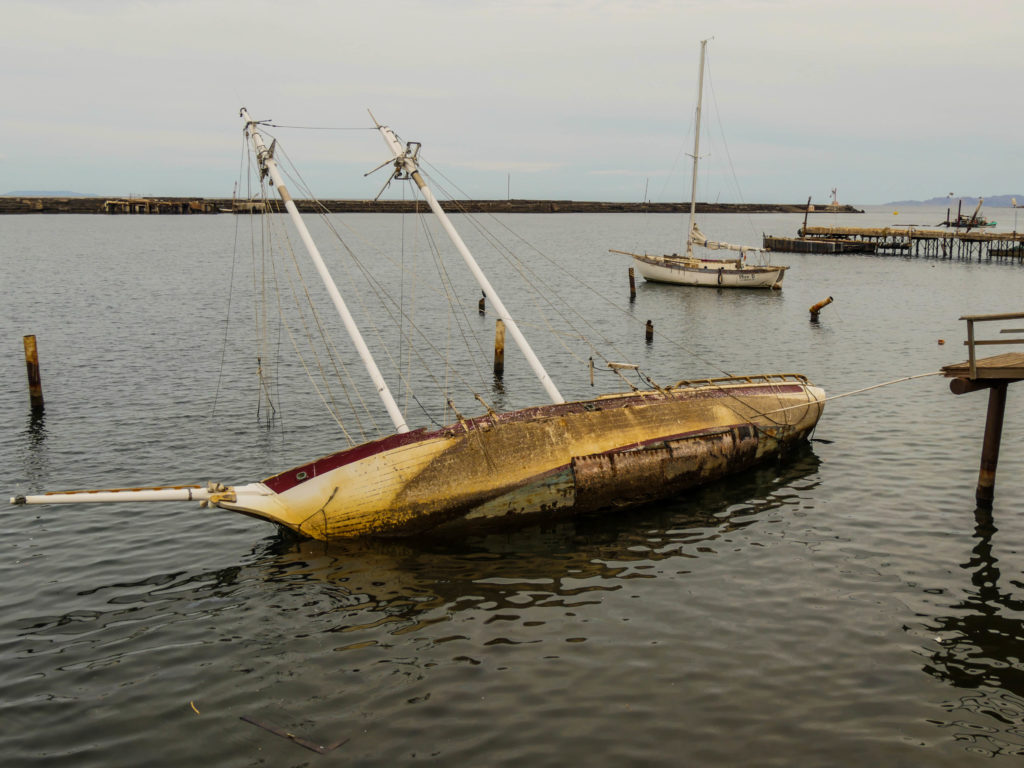
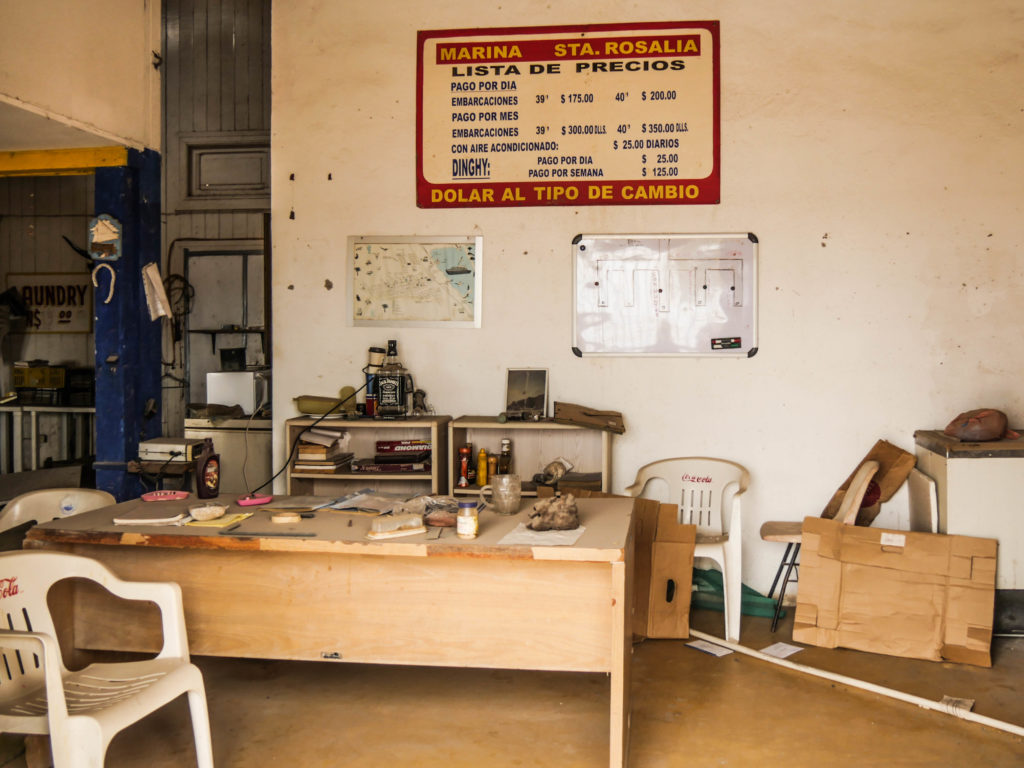
But we were the only ones yet to arrive—and we didn’t arrive for another month. This experience was eerie—having the sea all to ourselves meant all of the little restaurants we might have eaten at were shuttered, and we couldn’t exchange stories and information with other sailors.
The sailing community wasn’t the only tourist group that deserted Baja. The season’s heat and humidity typically slow down general tourism in Baja—except for the sport fishing industry. The summer is the only time in the Sea of Cortez when the howling north winds abate. Instead of six- to nine-foot waves, there are calm seas for the fishermen. Thousands of people travel to the peninsula every summer with hopes of reeling in a sparkling green dorado (mahi mahi) or a coveted Yellowtail. Towns like Loreto and Bahía de Los Ángeles attract sport fishers of all nationalities, but largely American and Mexican men flock to these areas to see if they can land a tuna for dinner or a swordfish for a photo. Charter fishing boats or pangas head to the sea for the sport of rod and reel, trolling the sea mounds (underwater mountains) and coasts hoping to lure, catch, and fight a thousand-pound Blue Marlin (which is usually returned to the sea.) These are considered high-value tourists who pay a boat and guide daily or weekly to take them to sea.
Even summer’s calm seas couldn’t help the fishers this year. The big game fish simply weren’t there. This is not the direct impact of Hurricane Odile, but an indirect result of the larger cause of powerful hurricanes: the warm waters of El Niño. Warm water is less nutrient rich, and when the sardines, anchovy, and squid have nothing to eat, that ripples up the food chain. On land, fishing boats sat idle as reports of poor fishing circulated through online communities and word of mouth, and sport fishermen did not return for the season. Josh and I experienced the lack of deep water fish as well. We tow two lures behind the boat, and when we sail over 5 knots, we often catch fish. This summer, we failed to catch even one.
Despite the dip in sport fishing, some industrious fishers in Bahía de Los Ángeles diversified to fill the void. Instead of taking people fishing, they guided tourists and school groups in the bay to show them their remarkable summer visitors: the largest shark in the world, the whale shark. Whale sharks can weigh in at 15 tons and a length of 45 feet, and despite the ‘shark’ moniker, their only real threat is to the plankton community. The sharks come to Bahía de Los Ángeles for the summer to feed. With an average speed around 3 miles per hour and their tendency to feed near the surface, they make a great snorkeling companion. For unknown reasons, but perhaps because of the cooler water in the Bay (kept cool by the relentlessly strong tidal currents in this area of the sea), the whale sharks increased from 180 individuals to at least 197 this year. We saw multiple boats taking to the water every morning with people excited to witness these graceful giants.
This video, shot and edited by Josh Moman, lets us into the graceful world of these giant fish in Bahía de Los Ángeles.
Even as tourism continued to suffer after Odile, pockets of positive ecological changes coupled with social flexibility drove a more diversified tourist economy in places like the Bay of L.A. A few of the fishermen, like Joél Prieto, had already seen the potential to cater to researchers from San Diego and Ensenada, and built relationships that carried them through the sport fishing bust.
“It’s just what you have to do,” Joél said. When I talked with him and others who did this kind of work, I realized that they had a strong ethic around their fishing practices that made them powerful conservationists for their piece of the sea. Ironically, poor fishing had made conservationists out of fishers—potentially allowing local fish populations to recover from human overharvesting.
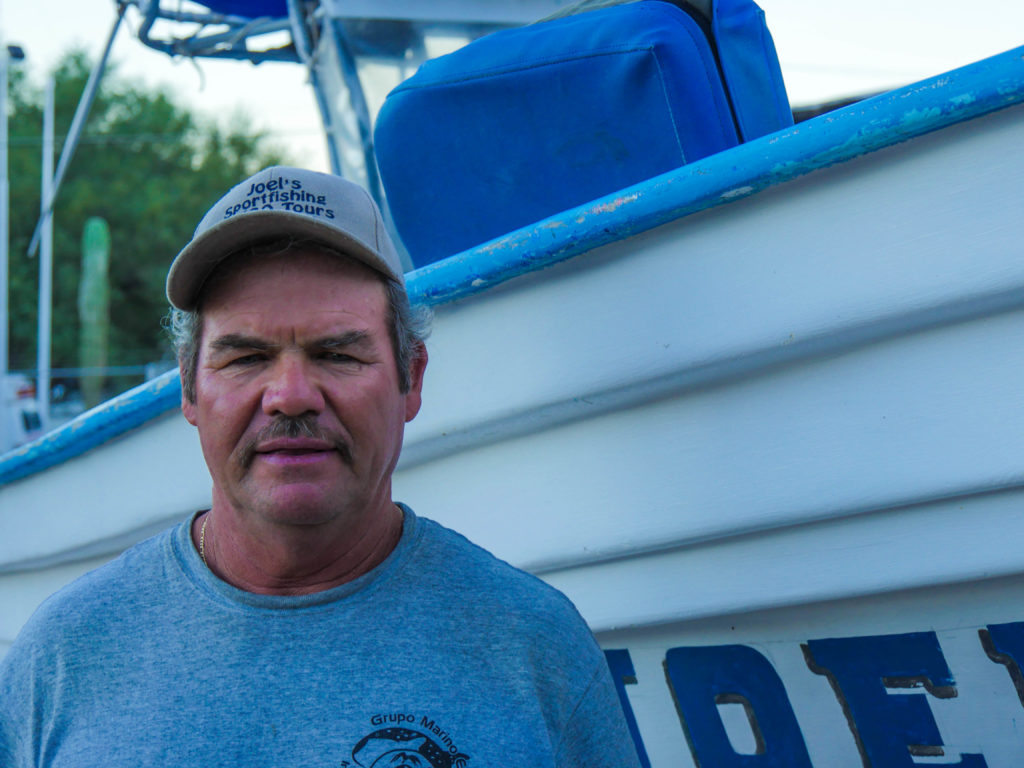
Disease
Hurricanes bring torrential rains that not only tear away hillsides, but they leave a seemingly innocuous threat: standing fresh water. Typically, fresh water is a celebrated rare commodity in the desert. However, cities and towns have plenty of unnatural ways to accumulate fresh water, like old tires and concrete washbasins with no drain (ubiquitously used for laundry in Mexico, but a dying tradition as electric washers replacing hand washing.) These are the perfect breeding grounds for mosquitoes. And mosquitoes bring deadly disease.
When we first arrived in La Paz, two weeks after Hurricane Odile, there were 432 reported cases of dengue fever. Dengue, also known as breakbone fever, is a viral infection transmitted by the Aedes aegypti mosquito. It causes a rapid high fever, debilitating joint pain, and serious cases can lead to internal hemorrhaging and death. The Aedes mosquito is active both day and night, but an individual mosquito generally lives in a 150-meter radius. Therefore, this disease often affects everyone on an entire block, while other areas remain untouched.
In La Paz, trucks and planes sprayed malathion, a powerful insecticide, into the air in communities. When we arrived in La Paz, we lived on land with a friend and her two dogs. When we heard the truck or plane coming, we would snatch the dogs from the yard and hurriedly close all the windows and doors. Regardless, we would find all insects inside and out belly-up after a spray-by.
As we traveled up the coast and I asked people what had changed, every single community mentioned dengue. In Agua Verde, people spoke about it with much force—everyone had dengue last year, they said. Although there was only one reported death from dengue in Baja Sur, crippling the entire population of a small fishing town means that breadwinners cannot work for weeks—a severe blow to a family dependent on the summer fishing season (no matter how bad it may be.)
As the globe warms, the disease has spread northward out of the tropics and into the southern US. As more powerful hurricanes bring more fresh water to the area, it provides a watery path for the disease to thrive not only in Mexico, but the drier regions of the US like Texas and Arizona. Stronger hurricanes in Mexico bring disease into the US on tiny wings.
Infrastructure
Loreto, ten miles north of Puerto Escondido, was the capital of the state of Baja California Sur until 1918, when hurricane floodwaters nearly wiped out the town. The capital was moved to La Paz for fear of future devastating floods. Flash floods from storms continue to inundate the town every summer and fall. (The town sits at the base of the towering Sierra de la Giganta Mountains and receives a disproportionate accumulated runoff from these peaks.)
To combat the flooding as the population doubled in the past 30 years, the municipal, state, and federal government built increasingly tall and substantial berms for the town arroyos. During Hurricane Odile, these barriers fell in very little time to the torrent. Entire communities were swallowed in two to four feet of rushing water. Many of the roads were not engineered to properly shed water towards the nearby ocean. When we stayed in Loreto with friends during a tropical storm this year, we witnessed their street flood with nearly a foot of water.
Al and Kathy Suter and their neighbors could only watch from their second story after the water broke through the reinforced arroyo walls and flooded their neighborhood. Video courtesy of Alois Suter.
However, that was all that happened—their first floor did not flood with mud and water this year. This is because Hurricane Odile spurred a remarkable, coordinated change. After Odile, the federal tourism agency, FONATUR, and the municipal government chipped in funds to build an engineered barricade to the storms. And it worked.
This was a change that happened throughout Baja, and not only with arroyos. Thousands of CFE (Comisión Federal de Electricidad) trucks and workers were poised and ready for the storms. They deployed from throughout Mexico to repair the 40,000 downed electrical poles—a massive task that was accomplished in impressive time, with most people receiving power within two weeks of the storm. In addition, thousands were mobilized to repair roadways. Josh and I were able to drive the entire length of the peninsula only a week after the storm—quite a surprising feat given all of the desert washes that run across this lonely two-lane highway.
The Loreto arroyo demonstrates a positive, lasting change motived by a catastrophic storm. Collaborative action between a federal agency and local government protected their citizens—the storm actually made an improvement in the lives of people living in Loreto.
The Future: Stronger Hurricanes in Mexico
Hopefully, Mexico can bring this lesson of fortified rebuilding to all of its shores—because it will have to. A year after Odile, Hurricane Patricia, which came ashore near Puerto Vallarta on October 23rd, smashed the global record for wind speed with sustained wind of 200 miles per hour. We were over 1,000 miles from this storm, safely anchored in the northern Sea of Cortez, but we will travel this route on our journey. What we have seen on the Baja California peninsula—changes for better and worse after the storm—gave us new eyes for understanding the scope of these more powerful storms.
Patricia continued a trend in extreme weather associated with the 2014 – 2015 El Niño that began with Odile and the 2014 hurricane season. The hurricane season extends from June 1st to November 30th and encompasses the Eastern Pacific region, from Nicaragua to the northern end of the Sea of Cortez. Residents on the coast will tell you that hurricane season is typically in August and September—but Patricia came a month late.
In addition, Patricia gained strength at breathtaking speed. (I actually gasped when I heard it over the radio.) We first learned about Patricia on October 20th in a daily marine forecast, when it was a vast disorganized group of thunderstorms in the Gulf of Tehuantepec with only a ten percent chance of formation. Usually this means that we won’t hear anything of consequence about a storm for at least a week, since it needs time to build and consolidate over tropical waters. However, within two days Patricia was not only a hurricane, but a Category Five, the biggest and baddest on the Saffir-Simpson scale. On October 23rd, a specialized plane that flies through the eyewall of the hurricane recorded sustained wind speeds of 200 miles per hour, and the pressure was the lowest ever recorded at 879 millibars. (For comparison, a typical sunny day is around 1015 millibars, and Hurricane Katrina came in at 902 millibars.)
So how did this happen with Patricia? And was it related to Odile?
Yes—but a few factors are at play. In 2015, the Eastern Pacific is experiencing the strongest El Niño ever recorded. The warmer waters of El Niño feed storms with the heat and moisture they need to develop, including Odile. But that’s not all. There is also an indication that the Pacific Decadal Oscillation, a natural wobble between cool and warm in the Pacific on the scale of decades (as opposed to every three to five years for El Niño), is shifting from cold to warm. Due to a decade of cooler water, the Pacific has absorbed much of the heat generated by global warming—but now it appears to swinging back to warm. (And it also seems that strong El Niños can push the oscillation toward a shift.) On top of all this, climate change adds heat to the ocean, and as the two cycles fall in step, it dumps fuel on the fire.
Scientists at the National Oceanic and Atmospheric Administration (NOAA) and the Massachusetts Institute of Technology (MIT), two leading institutions on hurricanes, hesitate to attribute any one storm to climate change, since there are other factors that can influence the development of a storm. Hurricanes start all the way over in Africa, with a low pressure system known as a tropical wave. The system travels west over the Atlantic Ocean until it crosses the narrow Gulf of Tehuantepec in southern Mexico. If a tropical wave meets light winds and plenty of warm moisture in the Pacific, it can spin up into a cyclone. Patricia gained her strength so rapidly from unusually light wind sheer and lots of warm water and moisture.
The potential for stronger storms increases with warm water, and it’s widely agreed that warming will lead to more powerful storms over time, even if scientists do not yet have enough data from these powerful storms to pinpoint the climate cause. As Eric Pooley, senior Vice President at Environmental Defense Fund said in a tweet (after Hurricane Sandy): “We can’t say that steroids caused any one home run by Barry Bonds, but steroids sure helped him hit more and hit them farther. Now we have weather on steroids.”
Patricia hit the mainland Mexico coast then rapidly degraded into a remnant low within 24 hours, but reports emerged afterwards of entirely leveled coastal towns. Chamela and Barra de Navidad, both popular and rural sailing locations, were flattened. Zero people were killed in Mexico because of a coordinated evacuation by state and federal governments—and because the hurricane eye narrowly missed big population centers. Unfortunately, the rural communities are left to rebuild and reimagine themselves over the coming years. But if Baja is any indication, the adaptability already needed to survive in these more remote places may help carry them through.
For now, Mexico seems to have the resilience to combat big storms. As the world sat down in Paris to talk about climate change, those individuals with limited resources in Mexico continued to adapt to the impacts of Odile and Patricia. Paris does not experience hurricanes, but winds of change will blow there that will be felt around the globe, echoing into tiny towns in Mexico.
* * * *
In Bahía de Los Ángeles, I spoke with fishers and divers who had worked in the community for their entire lives. When I asked them what was different now, they all told me that they used to be able to rely on the weather. But now, they cannot predict the weather like they used to.
“It changes the rhythm of life and work,” Joél told me. When I asked about what he hopes for the future of his town, his blue eyes looked lost for a moment, then he answered slowly.
“I hope that the people will have a bigger conscience.”
1 Academics and policymakers alike can speak quantifiably about the real potential to “decouple” carbon emissions from economic growth, but this depends on both a country’s ability, willingness, and funding to forge into technologically advanced spaces to upgrade their current electrical, industrial, and transportation at the scale necessary to fuel a hungry and growing population.
2 United Nations Office for Disaster Risk Reduction, 2015. The Human Cost of Weather Related Disasters. http://preventionweb.net/go/46796
3 World Bank, 2014. Turn Down the Heat: Confronting the New Climate Normal. Washington D.C.: World Bank. Creative Commons (CC BY-NC-ND 3.0 IGO).
4 Technically, it is tied for strongest with Hurricane Olivia in 1967, but won for destructiveness.

